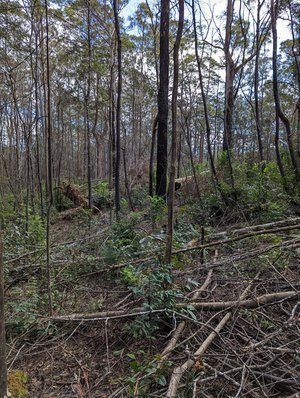We discuss how rainforests control fires and local Koala habitat near an old growth Warm Temperate Rainforest in the mountains behind Dorrigo NSW. These are wet meisic forests, with unique flora and fauna. There is so much to learn about the benefits they provide.
On a walk around ancient trees we looked up to see bright green light eminating from birds nest ferns high in the canopy. Majestic trees tower to the sky. We are careful where we step as there are tiny cotyledons of trees popping up, sometimes on mass. Its like being a kid in a lolly shop, at every turn there is another surprise, a moss covered tree, a sound, a feeling of being of the earth. When in this space, time is immaterial. I feel the health benefits as my feet sink in spongy leaf litter over deep moist soil. Its dark and still, your are enclosed in nature. Poderoos and Bandicoots have been nusling into the ground digging profusely for their favourite truffles. Standing still we hear enchanting bird sounds, not found on our surrounding farm paddocks. This forest is almost identical to the forest that existed 180 million years ago when 3 continents called Gondwana were joined. Then, dinausaurs would eat leaves and fruit, others would hunt down slower species crashing through what is a now a very tranquil place. There were larger trees back then, you can still see where the loggers toiled to get them out . A few large stumps are spotted throughout the forest, some 3 metres in diameter. On deeper inspection there is a miriad of life in the soil, in the trees and in the water. Only 200 years ago Gondwana wet forest covered a lenght of 2000km on the Australian east coast, only 1% of it now remains.
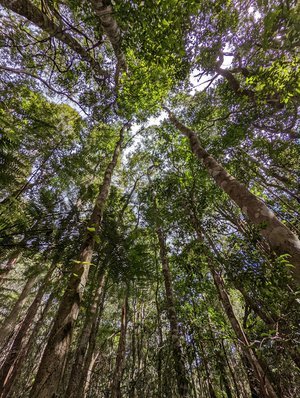
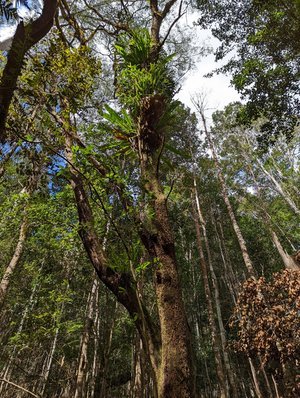

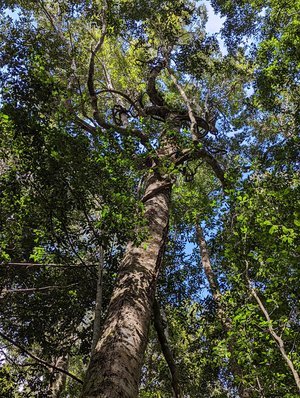
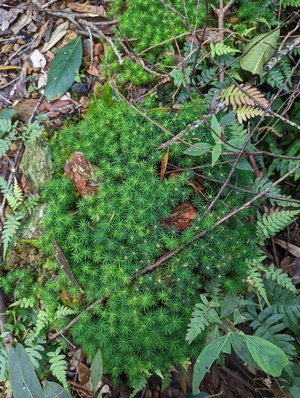

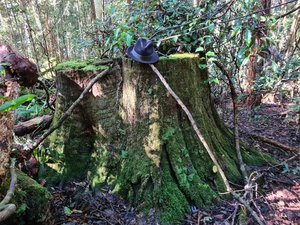
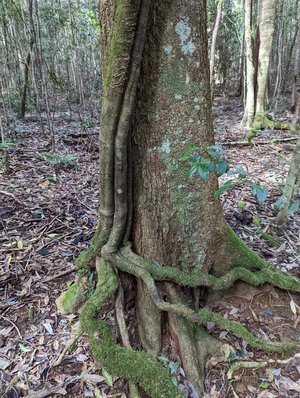
As we walked every new bird song initiated an perplexed look at each other as we stand frozen, not to make a sound ourselves. After the bird songs stop we confirmed the sounds on our Bird App. Paradise Rifle Birds, White Throated Tree Creepers, Pale Yellow Robins, are all birds that stay in the deep forest. The Tree Creepers with their long beaks need rough barked trees, the high surface area provides a sufficient food source. They creep along tree trunks and branches pecking continuously to catch their daily meal. Without these rough barked giant trees, the birds would not be here. Paradise Rifle birds stay high in the canopy on a horizontal branch, the males exibiting elaborate dancing rituals to impress mates. As we ambled, we could hear two Rifle birds communicating from each side of the forest with their raucus screaming call. Koala scratches were spotted on their favorite food trees on the edge of the rainforest. We could see where they energetically pulled their chubby bodies up the line of least resistance on a huge Tallowood. Some of the many tree species present in the forest were Red Ash, Pink Cherry, Mountain Walnut, Rose Wood and the Ancient Dorrigo Waratah. Tree Waratahs are from the Proteaceae family an ancient lineage with a fine mesh of roots. They require a mychorrizal fungi on their roots to prosper. Tree species that seed in the rainforests, are often dispersed by birds who eat their fruits. A complex ecology, where the many species allow it all to function. A big carbon sink which sheds pure water.
Pictures above: Tree creeper, Giant Barred Frog, Koala markings, Paradise Rifle Bird
At night a range of frogs and nocturnal snakes come alive, one food for the other. In this forest is the Giant Barred Frog and Stuttering frogs, both endangered. As we walked we continued to hear the gurgling of our meandering creek as it flows over rocks and into large pools. I often sight a pair of Platypus’s frolicking in the water or scatching themselves on fallen logs. The water apearing from nowhere, is feed by the surrounding forests and appears as a spring in this rainforest.
Rainforest forms a barrier to fires by the fact that it is so wet. Leaves on the ground, although thick form a mass of moist debri. It is home to a range of invertebrates recycling carbon. We discuss how the the calm feeling within, guided us to the best path, avoiding vines and moss covered logs. Interestingly where the fires did not damage this forest, there are few flammable species. Leaves of many species are thick and fleshy.
Other species of interest is a small plant Ziera smithii which grows in forest clearings, they have medicinal properties. These and other plants spur Dorothy and I to explore on the commercial part of our farm. I know that walking in this forest is good for you physically. There is a meditative aspect to it too. Walking in forests is carried out in a number of countries for medical reasons, they call it forest bathing. The native Gardenia, Atractocarpus benthamianus attracts bees with its smell, and me!. The water from our creeks, is clean and drinkable, eventually it feeds the cities of Grafton and Coffs Harbour. Keeping it clean and flowing, is essential for people as well as the fauna and flora here. All part of our natural capital.
In 2019 the local area was subject to extremely dangerous fires, 60 houses were destroyed just a little North of our property. Fires are a common phenomina in Australia, but never in rainforests. They are becoming more prevalent due to climate change, scientists say. Fires do more than harm trees, thick ash pollutes water supplies, smoke damages our lungs. This area and the whole of NSW was covered in harmful smoke for months in 2019.
There is extensive clear felling of forests taking place just to the north of us, by the Forestry Corporation of NSW. Incidently this land was Koala habitat. The quick growing plants that spring up after clear felling, just add extra fuel to burn the rainforest and our homes. Much habitat in the forms of hollow nesting logs are lost with this logging method. Although there are rules on what can and cant be logged, I have been told these are not always followed.
On our property, some fires, did creep into the rainforest and did quite a bit of damage to two hectares. Where the fires came through in 2019, large rainforest trees were killed, they do not have the fireproof bark protections or growth habit of drier species like Eucalypts or Acacias. Where the fires were intense surrounding the rainforest, the forest floor is strewed with blackened fallen logs. Where there is light new flammable seedlings are now appearing with an abundance. On a windy night I can hear still hear dead trees from 2019 crash thunderingly in the forest from our home a 1000 metres away.
Photos above: Tick bush, Acacia binervata and A. melanoxylon all are highly flammable. This is scary in terms of damage to the rainforest that will occur in the next and inevitable fire.
The locals tell me about the tragic events after the long drought ending in 2019. People tried to save property by lighting defence lines only to find scorching winds blow them towards houses. There was no water left in the creeks and they used harvestors to open up forest tracks as all the bulldozers were off fighting fires elsewhere. There is a great deal of publicity when the fires are burning, and the firebrigades are risking their lives. But proactive actions in better times are neeeded too. They say that if you burn it, it will burn harder next time. Careful management of the land is needed. Timber and logging can be a sustainable business if done selectively allowing for a diverse habitat for plants and animals. Old growth forest like ours and its scarcity is critical to maintain. We need to protest against the poor logging practices by our government and its contractors.
Rainforests form a protective moist shield as is evident on our farm. For the sake of the country, rainforests need to be saved. Seeds are scarce, small trees or seedlings in the rainforest may be the only stock available for the future. They wait in readiness for a break in the upper canopy, for the light needed for grow. Species like Rosewood can stay in a state of suspended growth or as seed in the ground for 10 years, waiting for an opportunity to grow. It is critical to protect this process as early loggers removed many of these iconic tree species.
Today with our new appreciation, we eagerly pulled out flammable seedlings. Our job is to look after the rainforest, and ensure fires do not enter. We will extend rainforest plantings and provide an access track to help fight fire in the future. I have planted a number of provenance species and labelled them on a walk towards the forest to educate people on guided tours of our farm. Our guests find the farm facinating, enjoying the range of birds and hopng to spot the ellusive platypus. As darkness falls the joy of watching the dancing flames around a campfire, our weary bodies sink into a darkening sky full of stars and the occasional comet.
Robert Griffith rob@greenlook.com.au, 0468 787 071






